How to choose the best walk-in bathtub
Learn how to choose the best walk-in bath for you
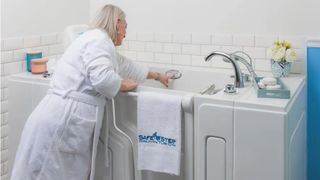
Finding the best walk-in bath requires a lot of research and consideration. When you're looking to invest thousands of dollars, you need to make sure you understand the various types of walk-in baths. You need to know what features to look for and what questions to ask before you buy.
In this article, we've done the research and collated the most common questions you need to ask yourself before you buy and the questions most people ask about walk-in tubs.
- How we evaluate walk-in tubs
Types of walk-in tubs
While every walk-in tub serves the same primary purpose - a tub that minimizes the risk of falling - you have many options to choose from:
The Soaker: a simple tub. It’s no different than a standard bathtub, in that it fills with water for you to soak in. The only difference is it’s a walk-in tub.
Hydrotherapy: a tub with water jets designed to massage muscles and joints to provide pain relief.
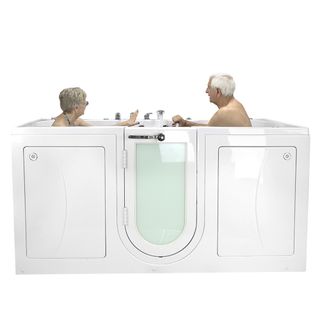
Aerotherapy: a tub with air jets. The purpose is similar to a waterjet, to provide therapeutic benefits, but air jets are easier on sensitive skin.
Aromatherapy: Usually combined with a hydrotherapy or Aerotherapy tub, the tub releases essential minerals and aromas into the water for a spa-like experience.
Are you a pro? Subscribe to our newsletter
Sign up to the TechRadar Pro newsletter to get all the top news, opinion, features and guidance your business needs to succeed!
Wheelchair Accessibility: a walk-in tub with an extra wide door and strategic handrails for getting from a wheelchair into the tub.
Bariatric tubs: a tub built to handle people who weigh over 300 pounds. These have a larger capacity, a reinforced structure, and larger door.
Questions to ask before you buy a walk-in tub
Most people assume that bathtubs are a standard size, but this isn’t the case. They can range between 50- and 80-inches long and between 30- and 36-inches wide. As such, before you speak with a sales rep, you need to measure your bathtub alcove so you know what size tub will fit. You can always fit a smaller tub into the space. Most manufacturers include an extension kit to fill the extra space.
How old is your plumbing?
If your waste drain pipe is very old, then it’s likely not to code. As such, you may find your tub doesn’t drain very fast, even if it has a quick drain system.
How is your mobility?
You need to honestly gauge your mobility. Do you have trouble stepping over an 8-inch step? Do you struggle getting up from a sitting position? Answering these questions honestly can help you pick the right walk-in tub for you. If you struggle getting out of a sitting position, then you’ll want to make sure you pick a tub that has a high seat and doesn’t recline you in any way. And if you struggle to step over anything, then a very low threshold step-in is necessary.
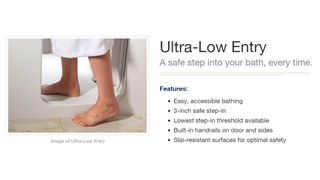
Can you afford a walk-in bathtub?
A walk-in tub is not cheap. Even the most affordable walk-in tubs cost thousands of dollars, without installation costs even considered. Are you able to afford these costs? The best walk-in tub brands offer financing to make the costs more affordable.
Do you have good credit?
If you can’t afford to pay for it all at once, you may need to finance the tub and installation. As mentioned, the best walk-in tub manufacturers offer financing, but only to people with good credit. Financing allows you to get the tub for a monthly fee rather than one large lump sum.
Will you need additional support built into your bathroom?
Walk-in tubs are heavy. Acrylic tubs weigh between 200 and 500 pounds without water. When filled with water, the weight can reach close to 1,000 pounds. It’s worth consulting with a structural engineer to make sure your bathtub alcove is structurally strong enough to hold this much weight. If not, you may need to have additional support built into it.
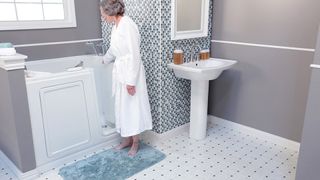
Frequently asked questions about walk-in tubs
How do walk-in tubs help elderly people who are injured or disabled?
The height of a standard bathtub is roughly 20 inches. If it’s a soaker tub, the height can be close to 30 inches. This ledge poses one of the biggest risks for seniors, who are already at a big risk for falling, and for those with mobility issues. In essence, it becomes a tripping hazard. And when you combine the slickness of water in the tub, the risk of fall on the way out is magnified.
As such, a walk-in tub is an excellent way to mitigate the risk of falling. The highest step-in threshold on a walk-in tub is 8 inches. Most are around 6 inches. The lowest are between 2 and 3 inches. And since the tubs have grab bars, you can steady yourself as you get in and out of the tub.
Additionally, if you can get over the top of a standard tub, you may find it difficult to get up from a lying position once in the tub. It’s not uncommon for seniors to find themselves unable to get out of a bathtub, even though they haven’t fallen. As such, a walk-in tub puts you into a sitting position so you can stand up and step out. The seat also minimizes the risk of falling if your senior loved one is taking a shower.
What are the potential therapeutic benefits of walk-in tubs?
The Arthritis Foundation recommends massages and heat as two natural methods for easing arthritic joints. By soaking in a hot bath with hydrojets massaging your back and joints, it’s easy to see how this can help manage pain associated with arthritis. But a good soak also helps in other ways. It can help improve circulation to the feet for diabetics. The relaxation helps ease stress and can bring your blood pressure and heart rate down. And according to the University of Texas at Austin, taking a hot bath 90 minutes before you go to bed leads to better sleep. And better sleep leads to better health.
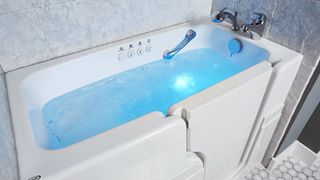
How much do walk-in tubs cost?
As mentioned, the low-end entry-level walk-in tub is likely to cost around $1,000 and often close to $2,500, depending on the brand. But if you want a good walk-in tub with hydro jets and air jets, it’s going to cost between $5,000 and $10,000. And none of this includes the installation costs.
What are the potential drawbacks of walk-in tubs? The biggest drawback is the installation and cost. Bathtubs aren’t easy to install and it can be costly just to remove your old bathtub, much less install a walk-in tub. Plus, at their most affordable, a walk-in tub costs roughly $1,900, but the cost can skyrocket to close to $10,000 depending on features and materials used. And installation often costs as much as the tub itself.
That said, a nursing home or care facility costs between $2,500 and $5,000 per month depending on where you live. If the most expensive walk-in tub costs about $15,000 (with installation included) and saves you from moving into a nursing home for years, then a walk-in tub is clearly the better financial decision. See, one of the biggest reasons seniors end up in care facilities is because they can no longer maintain a healthy level of hygiene. In other words, they can’t bathe themselves. Typically because getting into and out of their bath or shower is no longer safe. Well, if you’re able to safely keep taking baths and maintaining your hygiene regime, then you’re able to age in place independently, saving you the monthly cost of a retirement facility in the long run.
Another potential downside is the water capacity. It’s usually greater than a standard tub, so it takes longer to drain. And since you have to wait for it to drain, you might find yourself sitting in tepid water for several minutes before you can exit the tub. In addition, if the capacity of the tub is greater than your water heater, then you’ll run out of hot water before it fills up.
A more minor drawback is the cleaning of the whirlpool and air jets. If they aren’t being used regularly or cleaned, water can sit in the tubes and breed bacteria, which is usually harmless but can leave your tub smelling awful. Choose a tub with a self-cleaning jet feature to ensure this doesn’t happen.

Can a walk-in tub simply replace my current bathtub?
Most walk-in tubs are designed to fit into the same space as a standard tub, with the caveat that a walk-in tub is about 40 inches high. However, standard bathtubs vary in size. Your bathtub can be anywhere between 50 inches long and 34 inches wide to 72 inches long and 30 inches wide. As such, it’s a good idea to measure the area where your current bathtub sits, wall-to-wall. Make sure you shop for walk-in tubs that fit into those parameters.
Do I need to have a walk-in tub professionally installed?
Short answer is yes, get it installed professionally. Preferably even by experts from the manufacturer because they’ll know how to troubleshoot any of the various quirks related to your specific walk-in tub. But consider this, installing a regular bathtub is not easy and not recommended for the novice DIYer. Installing a walk-in tub is much more difficult. It requires several things — a great ability to measure and level objects, plumbing, electrical work, caulking, and more. Perhaps the floor needs to be reinforced to handle the additional weight of the extra water. Or maybe tile from the wall and floor had to be removed. Either way, hiring a professional is the safe option. Plus, many manufacturers will void a warranty if the tub is not installed professionally, so that’s something to keep in mind.
How much water do walk-in tubs require?
A walk-in tub holds roughly twice as much water as a standard tub of a similar length. So if your current bathtub holds roughly 40 gallons, then you can expect a walk-in tub to hold about 80 gallons. This amount of water means you should compare your water heater capacity against the water capacity of the walk-in tub before you purchase the tub.
How long do walk-in tubs take to fill?
How quickly do they drain? Most walk-in tubs come with fast fill faucets with a flow rate close to 19 gallons per minute. This would fill a 80 gallon tub in a little over four minutes. That said, water flow has a lot to do with the quality of your home’s plumbing and your home’s water pressure. Just because it’s rated for 19 gallons per minute doesn’t mean your home’s plumbing is capable of that. As such, use a stopwatch and time how long it takes for your current bathtub to fill. Then multiply by two and you’ll have a good idea of how long a walk-in tub installed in your home will take to fill up.

How long does a walk-in tub take to drain?
The best walk-in tubs either feature two 2-inch drains or a pump to quickly drain the tub. Manufacturers boast that these methods can drain a full 80 gallon tub in a matter of a minute, but the truth lies in your home’s plumbing. Regardless of how well these quick drain features work, if your plumbing is old and not to code (meaning the waste drain pipe isn’t as big as it should be), then the water can only drain as fast as the plumbing allows.
Are there any alternatives to walk-in bathtubs?
If the cost of a walk-in bathtub is beyond your reach at the moment, there are alternatives:
What safety features come standard?
Look for a walk-in tub that’s ADA certified. This means it meets the Americans with Disibilities Act requirements to have grab bars, easily accessed controls, non-slip surfaces, and a low threshold.
What features can be added to a walk-in tub?
The standard optional features for a walk-in tub are hydrojets, air jets, colored lights, and aromatherapy. You should also look to add an inline heater if it’s not included with your hydrojets, as this heats the water as it circulates through the jets. Some tubs offer heated seats or heated air blowers for the same reason. Also look for quick drain pumps, cushioned headrests, bidets (jets positioned on the seat for added cleanliness), towel racks, handshowers, and micro-bubble features.
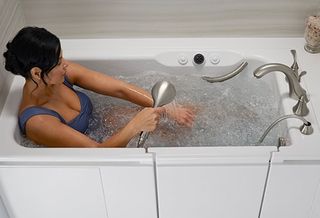
Can I shower in the bathtub as well?
Yes. Every walk-in tub we reviewed comes with a handshower. While not a shower in the strictest terms, a handshower allows you to rinse off from the sitting position, as though you were taking a shower. That said, you can also install a showerhead above the tub if you prefer a shower over a bath. Some manufacturers even have models with overhead rainfall showerheads.
What does "ADA compliant" mean?
To be ADA compliant, a product’s design must comply with the Americans with Disabilities Act. This means it meets specific safety requirements, such as where the controls are located, the clearance for the tub, non-slip surfaces, grab bars, and a seat. You can review these standards on the ADA.gov website maintained by the U.S. Department of Justice, specifically Section 607.
What is hydrotherapy?
Hydrotherapy is a term used to refer to any water-based therapy. It’s been common since ancient times to use hot and cold water to relieve pain and discomfort, as well as relax muscles and ease stress. With walk-in tubs, this refers to whirlpool jets, which provide deep muscle massages, and air jets, which provide a gentler exfoliating massage.
What is chromotherapy?
This is the use of lights under the water to promote relaxation. Some people find various colors glowing in the water creates an ambience that helps them relax.
Jeph Preece is an ambitiously creative writer, editor, and content strategist with over seven years of digital publishing experience and five years teaching and admin experience in academia. He is specialized in short-form and long-form, purpose-driven content. Jeph is also an accomplished artist, musician, and author of innovative fiction.

